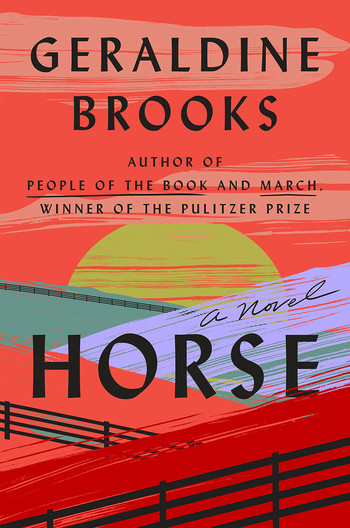A story of present-day interracial romance woven together with a history of thoroughbred racing in the antebellum South, Horse, a new novel by Geraldine Brooks ’83JRN, is no safe bet. Yet readers who appreciate rigorous historical research and polished storytelling should certainly stay the course.
The novel opens in Washington, DC, where art historian Theo is rescuing a painting of Lexington, one of America’s most renowned racehorses, from his neighbor’s trash. Theo takes the artwork to the Smithsonian for evaluation and is introduced to Jess, who is restoring the skeleton of the same horse for an exhibit. The encounter is awkward: Theo, who is Black, recognizes Jess as the white woman who had earlier confronted him when she thought he was stealing her bike. Weeks later, when the couple begin to fall in love, Theo will wonder how to answer the question of how they met, since “being tacitly accused of bike theft wasn’t exactly a meet cute.”
The action then shifts to 1850, to the day Lexington is born on the Kentucky farm of the physician Elisha Warfield. Warfield promises Harry Lewis, a talented Black trainer, an interest in the racehorse in lieu of a year’s wages — an exciting prospect, since Lewis hopes to use any future winnings to buy the freedom of his son Jarret, whom Warfield has enslaved. Jarret proves to be as talented as his father. He spends all his waking hours with the horse, and through hard work and unwavering commitment he eventually raises one of the greatest racing stallions in turf history. Unfortunately, his father will never live to see or profit from this achievement.
Brooks is known for undertaking extensive research, and in the novel’s afterword she says that as she pored over archives she was struck by the stories of the Black grooms, trainers, and jockeys who played a “central role in the wealth creation of the antebellum thoroughbred industry.” These key figures, of course, are hidden in the margins of history, a place Brooks is always eager to explore. Her novel March, which won a Pulitzer Prize, imagined the Civil War experiences of chaplain John March, the fictional father of the girls in Louisa May Alcott’s Little Women. Caleb’s Crossing, set in 1665, told the story of the first Native American to graduate from Harvard College.
Horse shifts between Jarret in 1850 and Theo and Jess in 2019 (with a whistle stop in New York City in the 1950s), and it carries the heavy burden of acknowledging the deep roots and painful persistence of structural racism. Jarret averts his eyes when he is asked for his opinion, acknowledging that “it wasn’t a good idea to speak to a White stranger without putting a deal of thought into it. Words could be snares.” One hundred and seventy years later, Theo, the Oxford-educated, polo-playing son of civil servants, cannot escape the racist tropes that pollute the most mundane interactions. When he goes to help a neighbor with her shopping, she flinches with alarm. “Theo felt the usual gust of anger and took a deep breath. Just a White woman, White-womaning.”
Geraldine Brooks, of course, is also a white woman, writing from the perspective of an enslaved man and a multiracial student confronting the disappointing limits of “woke” culture. It’s a bold choice for a novelist, especially when debates over cultural appropriation in fiction are heated and divisive. Brooks seems aware of the risk. In the novel, Theo’s own thesis takes issue with Frederick Douglass’s argument “that no true portraits of Africans by White artists existed; that White artists couldn’t see past their own ingrained stereotypes of Blackness.” In the afterword, Brooks takes pains to point out that she sought insights into the contemporary Black experience from several early readers, including Bizu Horwitz, the son she and her husband, the late journalist Tony Horwitz ’83JRN, adopted from Ethiopia.
Brooks’s novel started out as a story about a racehorse, but as she began to research the history of thoroughbred racing in America, Brooks writes, “it became clear that this novel could not merely be about a racehorse, it would also need to be about race.” And in the end, the novel is all about race. Despite the book’s title, the horse, Lexington, becomes less of a major character and more of an also-ran, and by making that choice, the novelist raised the stakes.



